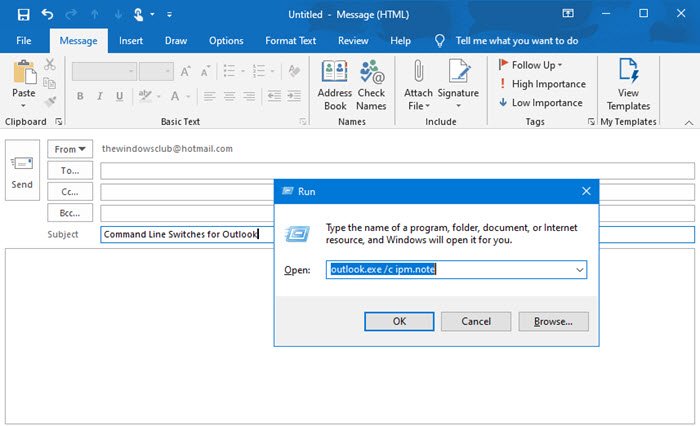Whether you’re troubleshooting a problem or just trying to speed up your normal usage, you can take advantage of Command line switches to carry out basic tasks in Microsoft Outlook on Windows 11/10 device – we show you how in this post.

Perform Outlook tasks using Command Line Switches
We take a look at a few command-line switches for Outlook to get started with.
Press Windows key + R to invoke the Run dialog.
In the Run dialog box, you can now input the following commands and hit Enter to execute the task.
Related: Microsoft Word Command Line startup switches.
Outlook Compose-line switch to send email
To compose a new message, enter the following into the Run dialog:
outlook.exe /c ipm.note
This will generate a blank Outlook email. It’s also possible to add the name of the email’s recipient by adding an extra /m switch onto the end of the command:
outlook.exe /c ipm.note /m obinna@TWC.com
The result is a new Outlook email with the recipient filled in.
You can even add an attachment by using the /a switch and specifying its disk location which opens an email draft
outlook.exe /m obinna@TWC.com /a "C:\My Documents\May2021Invoice.pdf"
As you can see, the ipm.note parameter was excluded from the command line switch. Unless you specify the instructions to attach the file to a different type of item, Outlook will assume that the user is trying to draft an email.
To attach content to a different item, such as a Task, all you need to do is add another switch to the command.
Read: Defrag Options & Command line switches.
Creating Other Items
By modifying the last element in the command used to send an email, you can create a variety of other Outlook items.
You can do so by adding the following parameters to the command line switch:
Creates a new contact
ipm.contact
Creates a new note
ipm.stickynote
Creates a new task
ipm.task
Creates a new appointment
ipm.appointment
Creates a new journal entry
ipm.activity
Read: Command Line Check Disk Options, Switches, Parameters.
Cleaning up Outlook
You can use switches also to clean up some parts of Outlook without opening the program.
Remove all names and email addresses from the Autocomplete register:
outlook.exe /cleanautocompletecache
Other parameters/switches that you can specify to clean certain things in Outlook are as follows:
Deletes any custom category names and restores category names to their default labels.
/cleancategories
Deletes client-based rules.
/cleanclientrules
Deletes server-based rules.
/cleanserverrules
Deletes both client-based and server-based rules.
/cleanrules
Clears and regenerates reminders.
/cleanreminders
Deletes any custom views and restores the defaults.
/cleanviews
Read: Command-line Shutdown options for shutdown.exe.
Opening and Finding Files in Outlook
You can also use switches to open individual files in Outlook without having to navigate through an email inbox.
The following command will open either a message file using the MSG format or a saved search that uses the OSS format – you just need to swap out file-name.
outlook.exe /f file-name
We can also swap out /f for /hol to open a HOL file, and /ical to open an ICS file.
In cases where you wangt to have the file name of the content that you’re looking for, you can use the following switch:
outlook.exe /finder
This will launch the Advanced Find search in Outlook.
Read: Run Microsoft Edge using Command line.
Opening Outlook using command-line
By taking advantage of switches, you can also open Outlook and perform other useful tasks at the same time.
To open up Outlook with the Reading Pane disabled, use the following switch:
outlook.exe /nopreview
You can switch out /nopreview for /safe to disable both the Reading Pane and any active toolbar customizations.
Alternatively, you can initialize Outlook and open a specific folder by using the following command.
outlook.exe /select folder-name
Replace folder-name placeholder with the title of a particular folder or reference like the following:
outlook:calendar
To save time, you can open Outlook, look for new meeting requests in the inbox and adds anything it finds to the calendar by using the following switch:
outlook.exe /sniff
If Outlook crashes, you can attempt to open the same profile and folders that were active before the crash using the following switch:
outlook.exe /restore
Finally, if you want to initialize Outlook by using an Outlook window that’s already open (if one exists), you can use this command:
outlook.exe /recycle
That’s it on some of the command line switches you can use to perform basic tasks in Outlook on Windows 11/10!
Read next: Command Line Parameters for Remote Desktop Connections.
Leave a Reply